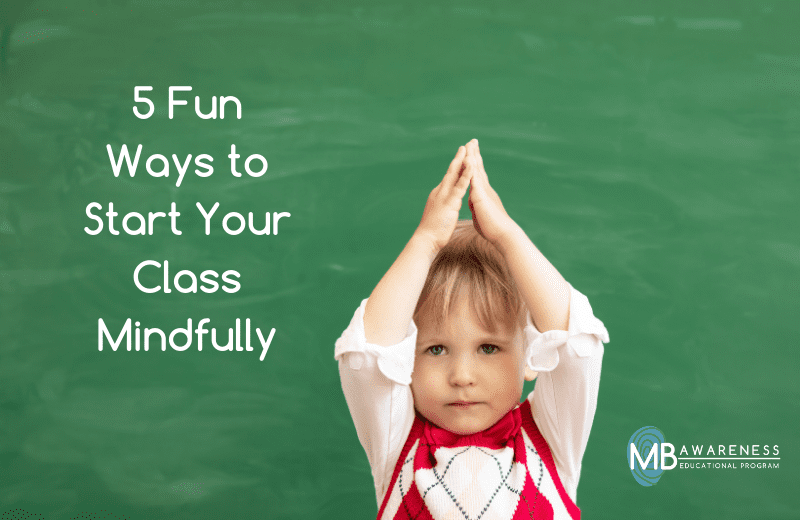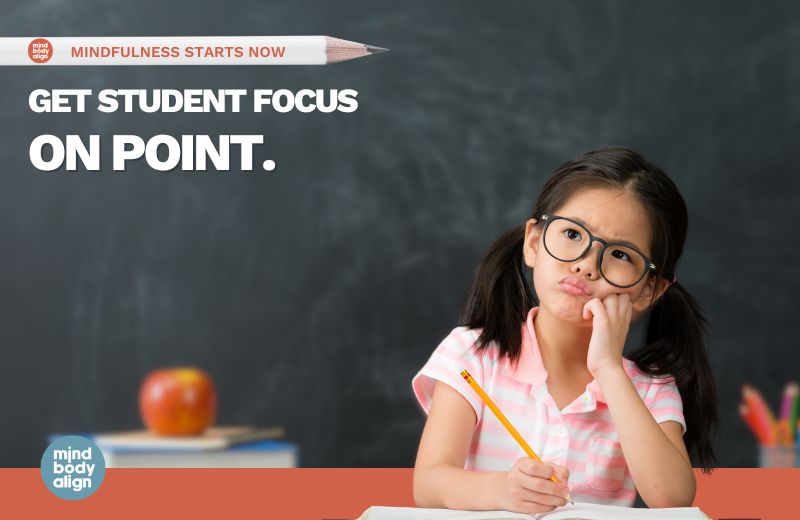How do you get your students to practice mindfulness when just getting them to sit still feels like a herculean task? Tap into their inner playfulness and imagination!
Make it feel like students are playing when they are practicing mindfulness. Simply by tapping into the power of imagination, by making it something of a game, a role-play or performance, students of all ages can increase their ability to focus, pay attention, and regulate their emotions. Teachers can make it fun by tapping into things kids already do and enjoy.
Here are 5 fun and engaging mindfulness activities to start the day that kids of all ages will enjoy. Get more mindfulness! Join our MBAwareness community to receive materials to use with your students, advance notice of events, live zoom guided conversations, and other surprise gifts.
Once you have joined us, start with these five tips!
- Daily Gratitude Practice
Humans are great at remembering the negative. Not so much, however, when it comes to recalling the positive. Being grateful helps us keep this balance in check. There’s no “right” way to practice gratitude, however, you may like to set aside the first minute of class for students to write down what they are thankful for, briefly share them with a partner, or silently think these thoughts to themselves.
While it does take practice, setting aside time to cultivate mindfulness will reap benefits for your students and for yourself as a teacher. As with any new skill, slow and steady is the best way forward. And the more you practice, the easier it becomes.
- Use Mindful Objects
Many classrooms have a signal of some kind that is used to bring everyone together or to focus their busy minds in preparation for a lesson. A bell is ideal for this purpose. When I teach mindfulness in schools, the students eventually take over ringing the bell periodically throughout the day and the teacher enjoys watching as the class focuses on the sound and comes into stillness. Giving the students control of the bell also gives the teacher valuable information about when the students need the break because sometimes we are focused on getting through the lesson, and possibly overlooking the needs of the students in the room.
Another favorite is a Mind Jar. This is a visual metaphor for how our mood goes from agitation to calm. You can easily make one for your classroom with a plastic or glass jar, some water, dish soap, and glitter. {Can link to our infographic here.} Each student can also make their own mind jar to use when they feel they need to calm down during the day.
The Hoberman’s Sphere, or belly ball, is another cool way to demonstrate deep breathing. As a teacher, you can help a whole class breathe deeply when you stretch the ball out and ask the kids to breathe in. When you squeeze the ball together, ask students to breathe out. It’s interesting for the kids, highly visual, and even tactile if you allow the kids to try it on their own.
- Brain Breaks or Mindful Moments
Our students are busy all day, going from class to class and constantly taking in new information and interacting with the world around them. We rarely give them a moment to pause, settle their nervous system, and refocus their attention and energy on a new task. At the beginning of class, ring the bell to signal a mindful moment and invite kids to close their eyes (if they’re comfortable doing so), and take a few deep breaths. They can pay attention to breathing — what does it feel like when they breathe in and out? Or they can notice their thoughts — is their mind really busy or quiet right now?
Brain breaks offer the class an opportunity to carry out a short mindful activity (breathing, stretching, check-in with their thoughts, etc). You’ll be amazed at how much more teaching time you have during the lesson because you started it with a moment of focus.
- Soothing Art Sessions
Start your class with a minute or two of coloring, doodling, or crafts, things that children already do and enjoy. Coloring, drawing, and painting help kids of any age to express their emotions and develop their creativity and imagination.
Another easy and fast calming activity is origami or paper folding. A quick internet search will provide you with many techniques that your students will enjoy. This activity can be combined with the daily gratitude practice, by folding the paper into a heart and writing a love note or something they are grateful for on the inside. To add a calming touch to this art routine, put on calming music in the background.
- Mindful Movement
Humans are born to move and movement is a natural part of human life that students don’t get to engage in very often in the regular classroom. Introducing movement to your classroom allows students to tap into their natural way of learning, develop self-expression, self-confidence, and healthy habits.
You can do it right in your classroom, even if you don’t have a ton of room, and all the movements can be adjusted for students who don’t want to stand or might have a physical limitation – they can do them seated if they prefer. Using movement that corresponds with your class topic makes the motion relevant and meaningful – be creative and give it a try.
Ending your class is also an important time to take a mindful moment. Take 1-2 minutes to have the kids close their eyes (if they wish) and focus on their breath. Ask them to think of what they have learned during the lesson or what they may have accomplished today. This gives them quiet time to settle their nervous systems before their next class or the next activity. This can happen at the same time as the exit ticket or lesson wrap-up.
Mindfulness has something to offer you and every child in your class. If you haven’t yet tried some of these simple and fun mindfulness activities with your class, now may be the time to see just how much they can benefit you and your students.
***Interested in learning more about Mindful Education in the classroom? Check out our available workshops now!










